NCERT Solution For Class 10, Maths, Chapter 5 Arithmetic Progressions, Exercise 5.2 has total 20 questions to discuss. all questions of class 10 maths chapter 5, exercise 5.2 is based on general formula of Arithmetic Progressions.
Table of Contents
Toggle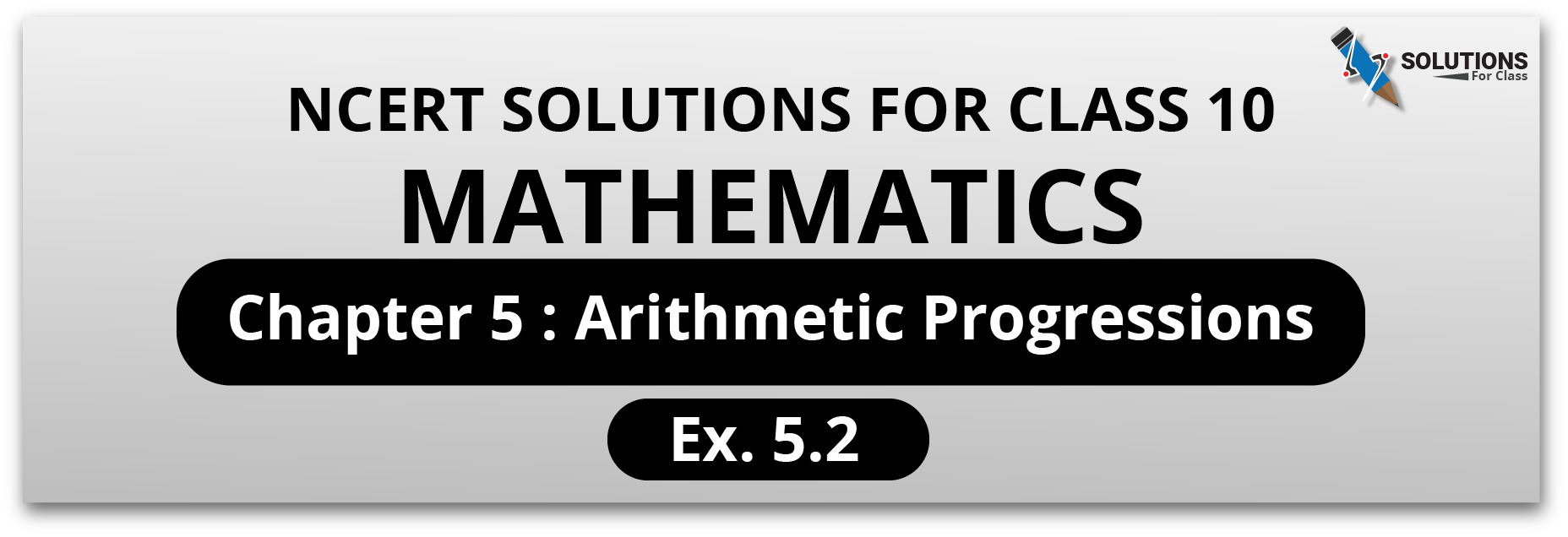
Class 10, Maths, Chapter 5, Exercise 5.2 Solutions
Q.1. Fill in the blanks in the following table, given that a is the first term, d the common difference and an the nth term of the AP:

Ans: Blanks may be filled as under:
(i) an = a + (n – 1) d
= 7 + (8-1)3
= (7) +(7×3) = 7+21= 28
(ii) an = a + (n – 1) d
⟹ 0 = -18 + (10 – 1) d
⟹ 18 = 9d
⟹ d = $\frac{18}{9}$= 9
(iii) an = a + (n – 1) d
⟹ -5 = a + (18 – 1) (-3)
⟹ -5 = a + 17 (-3)
⟹ – 5 = a – 51
⟹ a = – 5 + 51 = 46
(iv) an = a + (n – 1) d
⟹ 3.6 = – 18.9 + (n-1) 2.5
⟹ 3.6 + 18.9 = (n – 1) 2.5
⟹ 22.5 = (n – 1) 2.5
⟹ $n-1=\frac{22.5}{2.5}$
⟹ n – 1 = 9
⟹ n = 9 + 1 = 10
(v) an = a + (n – 1) d
an = 3.5 + (10.5 – 1) × 0
an = 3.5 + 0 = 3.5
Q.2. Choose the correct choice in the following and justify:
(i) 30th term of the AP: 10, 7, 4, ….. is
(A) 97
(B) 77
(C) –77
(D) – 87
(ii) 11th term of the AP: – 3, – , 2, …., is
(A) 28
(B) 22
(C) –38
(D) – 48 $\frac{1}{2}$
Ans:
(i) Correct answer, (C)
Justification: 30th term of the AP: 10, 7, 4, ….. can be calculated by:
Here, a = 10, d = 7 – 10 = -3, n = 30th term
We know that, an = a + (n – 1) d
a30 = 10 + (30 – 1) (-3)
a30 = 10 + (29)x( -3) = 10 – 87 = -77
So, (C) is the correct choice.
(ii) Correct answer, (B)

Q.3. In the following APs, find the missing terms:
(i) 2, ___, 26
(ii) ___, 13, ___, 3
(iii) 5___, ___, 9$\frac{1}{2}$
(iv) -4, ___, ___, ___, ___, 6
(v) ___, 38, ___, ___, ___, -22
Ans: (i) 2, ___, 26 be a, (a + d) and (a+2d)
∴ a = 2 and (a + 2d) = 26
⟹ (2 + 2d) = 26
⟹ 2d = 26 – 2 = 24
⟹ d = $\frac{24}{2}$=12
Thus, the missing term = a + d = 2 + 12 = 14
(ii) Let ___, 13, ___, 3 be
a, (a + d) and (a + 2d) and (a + 3d)
∴ (a + d) = 13 ……(i)
And, (a + 3d) = 3 ……(ii)
Subtracting, (i) from (ii), we get
(a + 3d) – (a + d) = 3 – 13
a + 3d – a – d = -10
2d = -10 ⟹ d = -5
Putting d = -5 in (i), we get
(a + d) = 13
(a – 5) = 13
⟹ a = 13 + 5 = 18
∴ The missing terms are
a =18 and (a+2d) = [18+2(-5)] = 18-10=8
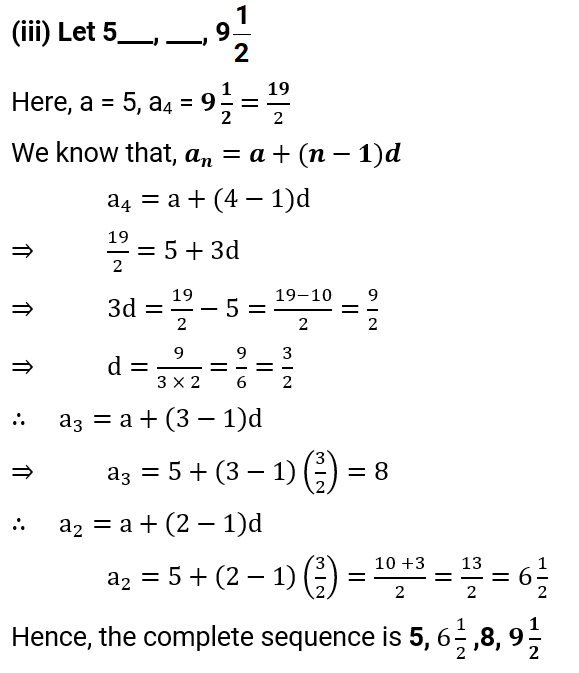

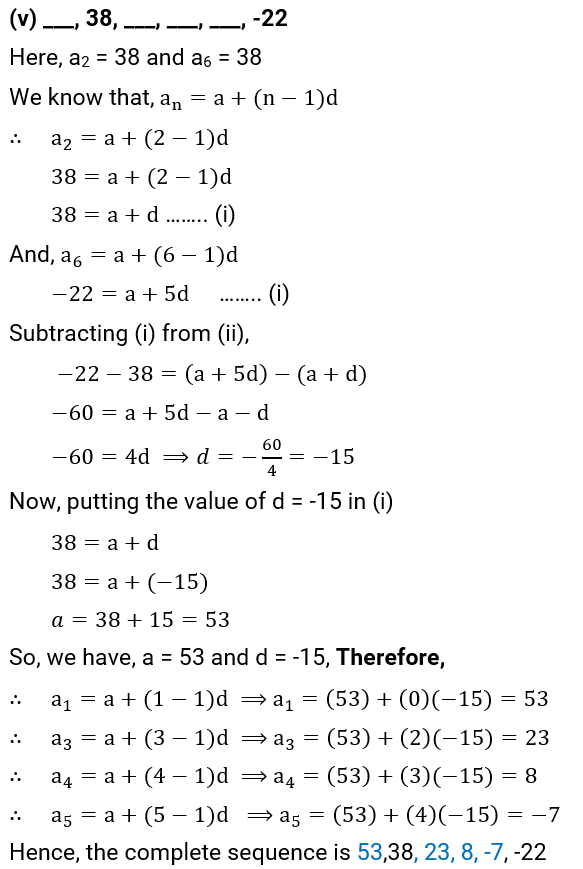
Q.4. Which term of the AP: 3, 8, 13, 18, . . . , is 78?
Ans: Clearly, the given list is an AP.
We have, a = 3, d = 8- 3 = 5
Let 78 be the nth term of the given AP then,
an = a + (n-1) d
⟹ 78 = 3 + (n-1) 5
⟹ 78 – 3 = 5n – 5
⟹ 75 + 5 = 5n
⟹ 5n = 80
⟹ n = $\frac{80}{5}$ = 16
Thus, 78 is the 16th term of the given list.
Q.5. Find the number of terms in each of the following APs :
(i) 7, 13, 19, . . . , 205
(ii) 18, 15$\frac{1}{2}$, 13, ….., 47
Ans: Clearly, it forms an AP with first term a = 3 and common difference d = 13 – 7 = 6.
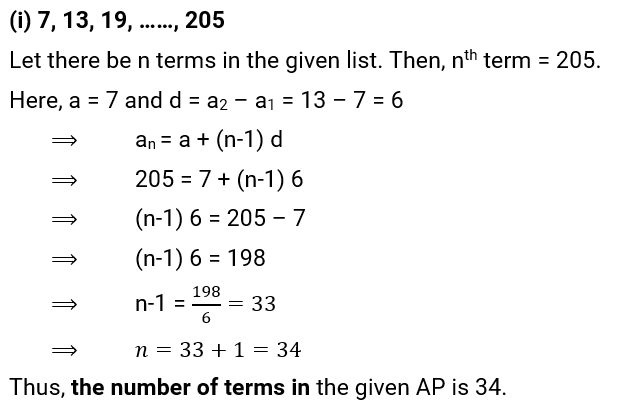
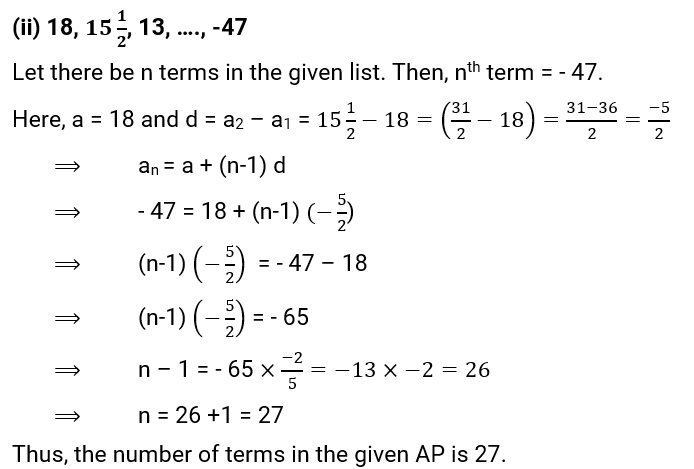
Q.6. Check whether – 150 is a term of the AP: 11, 8, 5, 2 . . .
Ans: Here a = 11, d = a2 -a1 = 8 – 11= -3
Let – 150 be the nth term of the given AP.
We know that,
an = a + (n – 1) d
⟹ -150 = 11 + (n – 1) (-3)
⟹ -3 (n-1) = – 150 – 11 = – 161
⟹ n – 1 = $\frac{161}{3}$
⟹ n = $\frac{161}{3}+1=\frac{164}{3}$
Here, the value of n is not an integer. Hence, -150 is not a term of the given AP.
Q.7. Find the 31st term of an AP whose 11th term is 38 and the 16th term is 73.
Ans: Let ‘a’ be the first term and ‘d’ the common difference
Now, an = a + (n – 1) d
∴ a11 = a + 10d = 38 ………………… (i)
And, a16 = a + 15d = 73 ………………… (ii)
Subtracting (i) from (ii), we get
5d = 35 ⟹ d == 7
And then from (i),
a + 10d = 38
a + 10 × 7 =38
⟹ a = 38 – 70 = -32
Now, we have a = -32 and d = 7
∴ a31 = a + (31 – 1) d
a31 = (-32) + (30×7) = -32 + 210 = 178
Hence, the 31st term is 178.
Q.8. An AP consists of 50 terms of which 3rd term is 12 and the last term is 106. Find the 29th term.
Ans: Let ‘a’ be the first term and ‘d’ the common difference
Now, an = a + (n – 1) d
∴ a3 = a + 2d = 12 …………… (i)
And, a50 = a + 49d = 106 …………… (ii)
Subtracting (i) and (ii), we get
47 d = 94 ⟹ d = $\frac{94}{47}$=2
Putting value of d in (i),
a + 2d = 12
a + (2 × 2) = 12
⟹ a = 12 – 4 = 8
Now, we have a = 8 and d = 2
∴ a29 = a + (29 – 1) d
a29 = 8 + (28 x 2)
a29 = 8 + 56 = 64
Hence, the 29st term is 64.
Q.9. If the 3rd and the 9th terms of an AP are 4 and – 8 respectively, which term of this AP is zero?
Ans: Let ‘a’ be the first term and ‘d’ the common difference
∴ a3 = a + 2d = 4 ………… (i)
And, a9 = a + 8d = – 8 ………… (ii)
Subtracting (i) and (ii), we get
6d= -12 ⟹ d = $\frac{-12}{6}$ = -2
Putting the value of d in eq.(i),
a + 2d = 4
a + 2× (-2) = 4
⟹ a = 4 + 4 = 8
Now, we have, a = 8 and d = -2
Let an = 0
⟹ an = a + (n – 1) d
⟹ 0 = 8 + (n – 1) (-2)
⟹ (n -1) (-2) = – 8
⟹ n – 1 =$\frac{-8}{-2}$ = 4
⟹ n = 4 + 1 = 5
Thus, 5th term of the given AP is zero.
Q.10. The 17th term of an AP exceeds its 10th term by 7. Find the common difference.
Ans: Let ‘a’ be the first term and ‘d’ the common difference.
It is given a17 – a10 = 7
⟹ (a + 16d) – (a + 9d) = 7
⟹ 7d = 7
⟹ d = 1
Hence, the common difference is 1.
Q.11. Which term of the AP: 3, 15, 27, 39, . . . will be 132 more than its 54th term?
Ans: Here, a = 3, d = a2 – a1 = 15- 3 = 12. Then,
an = a + (n-1) d
a54 = 3 + (54 -1) x12
a54 = 3 + 53 x 12
a54 = 3 + 636 = 639
Let an be 132 more than its 54th term
i.e., an = a54 + 132 = 639 + 132 = 771
⟹ 771 = a + (n – 1) d
⟹ 771 = 3 + (n – 1) 12
⟹ (n–1)12 =771-3
⟹ (n–1) = $\frac{768}{12}$ = 64
⟹ n = 64 + 1 = 65
Then, 65th term is 132 more than its 54th term.
Q.12. Two APs have the same common difference. The difference between their 100th terms is 100, what is the difference between their 1000th terms?
Ans: Let ‘a’ and ‘b’ the first term of two APs and ‘d’ is the common difference.
Given, a100 – b100 = 100
⟹ [a + (n – 1) d] – [b + (n – 1) d] = 100
⟹ (a – b) = 100 ……… (i)
Now, let the difference of their 1000th terms are ‘x’. then,
a1000 – b1000 = x ……… (ii)
⟹ [a + (n – 1) d] – [b + (n – 1) d] = x
⟹ (a – b) = x ……… (iii)
From (i) and (iii),
x = 100
Putting the value of ‘x’ in eq.(ii)
⟹ a1000 – b1000 = x
⟹ a1000 – b1000 = 100
Hence, the difference between 1000th terms is the same as the difference between 100th terms, i.e., 100.
Q.13. How many three-digit numbers are divisible by 7?
Ans: 994 is the last 3-digit number divisible by 7. Thus, we have to determine the number of terms in the list 105, 112, 119, …, 994.
Here, a = 105, d = a2 – a1= 112 – 105 = 7, an= 994 (last term) and n =? (no. of terms)
We know that, an = a + (n- 1) d
⟹ 994 = 105 + (n – 1)7
⟹ 7(n – 1) = 994 – 105
⟹ 7 (n – 1) = 889
⟹ n – 1 = $\frac{889}{7}$ = 127
⟹ n = 127 + 1 = 128
Hence, there are 128 numbers of three digit which are divisible by 7.
Q.14. How many multiples of 4 lie between 10 and 250?
Ans: The multiple of 4 between 10 and 250 are 12,16,20,24…. 248.
Here, a = 12, d = a2 – a1= 16 – 12 = 4 and an = 248
Let there be n terms in the AP Then,
∴ an = a + (n-1) d
⟹ 248 = 12 + (n -1) 4
⟹ 4 (n – 1) = 248 – 12
⟹ 4 (n – 1) = 236
⟹ n – 1 = $\frac{236}{4}$ = 59
⟹ n = 59 + 1 = 60
Hence, there are 60 multiples of 4 between 10 and 250.
Explanation:
We observe that 12 is the first integer between 10 and 250, which is a multiple of 4 (i.e., divisible by 4). Also, when we divide 250 by 4, the remainder is 2. Therefore, 250 - 2 = 248 is the largest integer divisible by 4(i.e., multiple of 4) and lying between 10 and 250. Thus, we have to find the number of terms in an AP with first term = 12, last term = 248, and common difference = 4 (as the number are divisible by 4).
Q.15. For what value of n, are the nth terms of two APs: 63, 65, 67, . . . and 3, 10, 17, . . equal?
Ans: It nth terms of the APs 63, 65, 67, … and 3, 10, 17, … are equal. Then
For 1st AP, a = 63, d = a2 – a1= 65 – 63 = 2
And, For 2nd AP, a = 3, d = a2 – a1= 10 – 3 = 7
According to question, nth term of both are equal. Therefore,
a + (n-1) d (For 1st) = a + (n-1) d (For 2nd)
⟹ 63 + (n – 1) 2 = 3 + (n – 1) 7
⟹ (n -1)7 – (n –1)2 = 63 – 3
⟹ (n -1) (7 –2) = 63 – 3
⟹ 5 (n-1) = 60
⟹ n – 1 = $\frac{60}{5}$ = 12
⟹ n = 12 + 1 = 13
Hence, the 13th terms of the two given APs are equal.
Q.16. Determine the AP whose third term is 16 and the 7th term exceeds the 5th term by 12.
Ans: Let ‘a’ be the first term and ‘d’ the common difference
Here, a3 = 16 and a7 – a5 =12
⟹ a3 =16 = a + (3-1) d
⟹ a + 2d = 16 ……………….. (i)
And, a + (7-1) d – [a + (5-1) d] = 12
(a + 6d) – (a + 4d) = 12
⟹ 2d = 12
⟹ d = 6 …………….. (ii)
Putting the value of d in eq.(i), we get
a + 2 × 6 = 16
⟹ a = 16 – 12 = 4
Now, we have, a = 4, d = 6.
∴ an = a + (n-1) d
a1 = 4 + (1-1) 6 = 4
a2 = 4 + (2-1) 6 = 10
a3 = 4 + (3-1) 6 = 16
a4 = 4 + (4-1) 6 = 22
So, the required AP is 4, 10, 16, 22, …….
Q.17. Find the 20th term from the last term of the AP : 3, 8, 13, . . ., 253.
Ans: Given AP: 3, 8, 13, . . ., 253
Here, d = a2 – a1 = 8 – 3 = 5
To find the 20th term from the last, we are reversing the given AP by using the common difference, therefore,
AP: 253, 248, 243, ……….13,8,3.
Now, we have a = 253, d = a2 – a1 = 248 – 253 = -5 and an = 20th term
We know that,
an = a + (n-1) d
⟹ a20 = 253 + (20-1) (-5)
⟹ a20 = 253 + (19) (-5)
⟹ a20 = 253 – 95
⟹ a20 = 158
Hence, the 20th term from the last term is 158.
we have, l = Last term = 253
And, d = Common difference = 8 – 3 = 5
∴ 20th term from the end = l – (20-1) d
= l – 19d
= 253 – 19 × 5
= 253 – 95 = 158
Q.18. The sum of the 4th and 8th terms of an AP is 24 and the sum of the 6th and 10th terms is 44. Find the first three terms of the AP.
Ans: Let ‘a’ be the first term and ‘d’ the common difference
Here, a4 + a8 = 24
⟹ [a+(4-1) d] + [a+(8-1) d] = 24
⟹ (a + 3d) + (a + 7d) = 24
⟹ 2a + 10d = 24
⟹ 2(a + 5d) = 24
⟹ a + 5d = 12 …………………(i)
and, a6 + a10 = 44
⟹ [a+(6-1) d] + [a+(10-1) d] = 44
⟹ (a + 5d) + (a + 9d) = 44
⟹ 2a + 14d = 44
⟹ 2(a + 7d) = 44
⟹ a + 7d = 22 …………………(ii)
Subtracting (i) from (ii), we get
2d = 10
⟹ d = 5
Putting the value of d in (i),
a + 25 = 12
⟹ a = – 13
Now, we have a = -13 and d = 5. Then, the first three terms are
∴ an = a + (n-1) d
a1 = (-13) + (1-1) 5 = -13
a2 = (-13) + (2-1) 5 = -8
a3 = (-13) + (3-1) 5 = -3
hence, the first three terms are, -13,-8,-3.
Q.19. Subba Rao started work in 1995 at an annual salary of ₹5000 and received an increment of ₹200 each year. In which year did his income reach ₹ 7000?
Ans: The annual salary drawn by Subba Rao in the years 1995, 1996, 1997, etc. is Rs 5,000, Rs 5,200, Rs 5,400, …, Rs 7,000
The list of these numbers are 5000, 5200, 5400, …….., 7000.
It forms an AP. [∵ a2 – a1 = a3 – a2 = 200]
Let after ‘n’ years his salary will be Rs 7000
∴ an = 7000 = a + (n-1) d
⟹ 7000 = a + (n-1) d
⟹ 7000 = 5000 + (n-1) (200)
⟹ 200 (n-1) = 7000 – 5000
⟹ n – 1 = $\frac{2000}{200}$ = 10
⟹ n = 10 + 1= 11
Now, to find required year, we have AP of years: 1995, 1996, 1997 …
Here, a = 1995, d = a2 – a1= 1996 – 1995 = 1
∴ an = a + (n-1) d
a11 = 1995 + (11-1) x1 = 1995 + 10 = 2005
Thus, in the 11th year (i.e., in 2005) of his service, Subba Rao drew an annual salary of Rs 7,000.
Q.20. Ramkali saved ₹5 in the first week of a year and then increased her weekly savings by ₹1.75. If in the nth week, her weekly savings become ₹20.75, find ‘n’.
Ans: Ramkali’s savings in the subsequent weeks are respectively Rs 5, Rs (5 + 1.75), Rs(5 +2×1.75), Rs (5 + 3×1.75), …
So it is a form of AP: 5, 6.75,8.5, 10.25,…..
Here, we have, a = 5, d = a2 – a1 = 6.75 – 5 = 1.75
And, in the nth week her saving will be Rs 20.75
∴ an = 20.75 = a + (n-1) d
⟹ 20.75 = 5 + (n-1) × 1.75
⟹ (n-1) × 1.75 = 20.75 – 5 = 15.75
⟹ n – 1 = $\frac{15.75}{1.75}$ = 9
⟹ n = 9 +1 = 10
Hence, in 10th week, Ramkali savings become ₹20.75.

